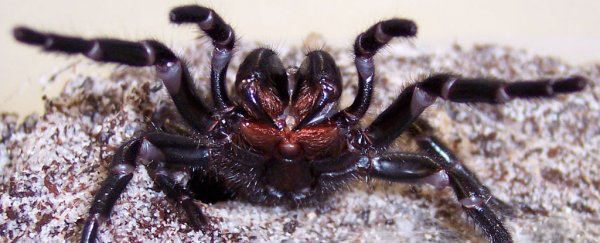The Australian funnel-web is one of the deadliest spiders in the world, but this poisonous predator may just hold the key to preventing brain damage caused by stroke.
Some 5 million people are left with brain damage every year after surviving a stroke, but a newly discovered protein found in the venom of the funnel-web spider (Hadronyche infensa) can protect neurons from cell death, even when administered hours after a stroke.
"We believe that we have, for the first time, found a way to minimise the effects of brain damage after a stroke," says venom researcher Glenn King from the University of Queensland in Australia.
"The small protein we discovered, Hi1a, blocks acid-sensing ion channels in the brain, which are key drivers of brain damage after stroke."
 Bastian Rast/The University of Queensland
Bastian Rast/The University of Queensland
In the majority of strokes, called ischemic strokes, the supply of blood and oxygen to the brain is cut off. In response, the body starts to break down glucose to compensate for the oxygen starvation, but this results in acid being produced, which can kill brain cells.
But the Hi1a protein – which so far has been tested with rats – stops this process from happening, by inhibiting brain cells' ability to detect acidic buildup, and preventing the neurons from dying.
The protein was discovered by accident when the researchers were sequencing the DNA of Hadronyche infensa, and they happened to notice that the peptide bore a molecular resemblance to psalmotoxin (PcTx1) – a compound isolated from tarantula venom that's previously been shown to confer protection to rat brains during induced strokes.
The resemblance encouraged the researchers to milk venom from three specimens of Hadronyche infensa to see if they could synthesise the protein and replicate the effects of PcTx1 with Hi1a.
"It proved to be even more potent," King told Ian Sample at The Guardian.
In testing with rats given induced strokes, the protein reduced the extent of brain damage by up to 80 percent in the animals' penumbral (cortex) region when administered 2 hours after the stroke, compared with control rats that were not given the compound.
"The untreated rats performed very badly after stroke. Their neurological and motor performance were terrible," King told The Guardian, whereas treatment with Hi1a "almost restored these functions to normal."
The protein was also effective in rats when administered several hours after the stroke was experienced – a potentially significant factor given that people who experience strokes can't always receive hospital treatment immediately.
A single dose given 8 hours after the stroke still reduced brain damage volume in the penumbral region by 65 percent, and also offered protection to the rats' ischemic (striatal) core, "the tissue directly impacted by hypoxia [which] is generally considered refractory to therapeutic intervention," the researchers explain in their paper.
Of course, there's no guarantee these protective abilities of Hi1a will extend to humans too – but the researchers are hopeful that they will, and are arranging plans to run clinical trials involving stroke patients in the next two years.
The team says if the trials are successful and that the protein proves to be safe, the treatment could one day be given via injections into the brain or via nasal delivery.
If that happens, it would be the first medication to combat brain damage resulting from stroke – plugging a huge gap in the world of medical treatment that we desperately need to fill.
"[It's] a failure of modern medicine," King told John Ross at The Australian.
"It's the second leading cause of death worldwide, and we really don't have a drug that can fix it."
